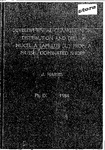DEVELOPMENTAL CHANGES IN THE DISTRIBUTION AND DIET OF NUCELLA LAPILLUS (L.) ^FROM A MUSSEL DOMINATED SHORE
| dc.contributor.author | Harris, Jean | |
| dc.contributor.other | School of Biological and Marine Sciences | en_US |
| dc.date.accessioned | 2012-08-06T14:33:39Z | |
| dc.date.available | 2012-08-06T14:33:39Z | |
| dc.date.issued | 1988 | |
| dc.identifier | Not available | en_US |
| dc.identifier.uri | http://hdl.handle.net/10026.1/1119 | |
| dc.description.abstract |
Aspects of the developmental biology of an intertidal predatory gastropod, Nucella lapillus were investigated for a population located on a mussel dominated shore at ^^ihitsand Bay, Cornwall. A field sampling programme revealed that the centre of abundance of. small Nucella {<3.4mm) occurred at lower shore levels than that of a ll larger individuals and the egg capsules. Laboratory studies danonstrated that hatchlings are both negatively geotactic and phototactic, directing than upshore and into crevices. The relative profitabilities of four different sized mussels to four developmental stages of Nucella v/ere investigated using both ability to promote grov/th and energy gain per unit handling time (E/Tj^) as measures of prey value. The response curves were similar m that proportionately large and small prey were less profitable than medium sized prey with the optimal prey size increasing with predator size. However the most profitable size according to the E/T^^ model was larger than in the grovrtli rate model because large meals appeared to be less efficiently utilized. An ontogenetic- shift in prey size selection was danonstrated in laboratory and field, the results of which were more accurately predicted by the grcwth rate model of prey value. Predatory events in the field were investigated using borehole dimension as an index of predator size. The feeding and growth of Nucella were investigated at differing periods of tidal atiersion. Growth rates were substantially reduced at anersion periods of above 30%, but these could not be wholly attributable to reduced feeding rates. Field growth trials danonstrated that a matiore size could be reached in 19-21 months, that growth does not cease at maturity, and that jxiveniles grow throughout the year. A strong correlation existed between growth rate and environmental temperature. Growth rates in the field were about 75% those in the laboratory, suggesting few constraints on foraging in the field. | en_US |
| dc.description.sponsorship | Plymouth Marine Laboratory | en_US |
| dc.language.iso | en | en_US |
| dc.publisher | University of Plymouth | en_US |
| dc.title | DEVELOPMENTAL CHANGES IN THE DISTRIBUTION AND DIET OF NUCELLA LAPILLUS (L.) ^FROM A MUSSEL DOMINATED SHORE | en_US |
| dc.type | Thesis | |
| dc.identifier.doi | http://dx.doi.org/10.24382/4903 | |
| dc.identifier.doi | http://dx.doi.org/10.24382/4903 |
Files in this item
This item appears in the following Collection(s)
-
01 Research Theses Main Collection
Research Theses Main


